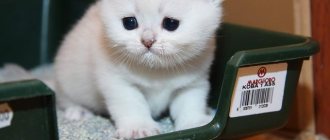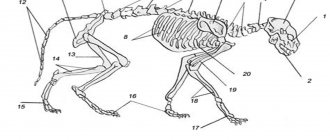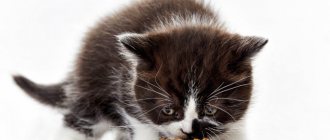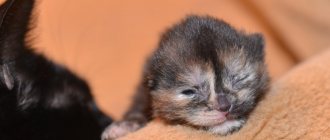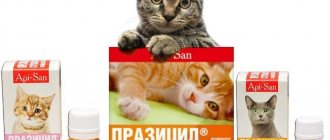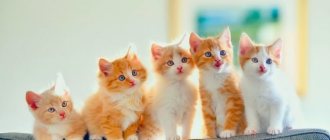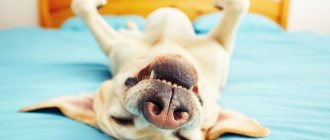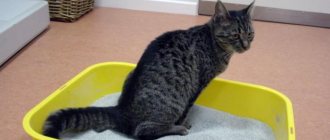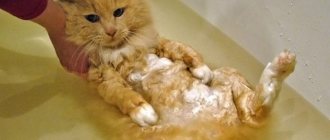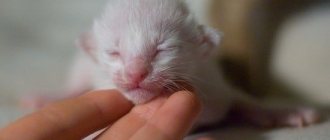How to train a pet to use a litter box? How often do kittens go to the toilet? Why do problems with stool and urination occur? Similar questions regarding proper care and maintenance most often worry owners and breeders of furry purrs.
more often than older dogs
Undoubtedly, a kitten needs care, attention, and proper care. At the same time, one of the important factors in the health of your beloved pet is the functioning of the digestive tract and genitourinary system. Let's consider how many times a day a small kitten should go to the toilet, what is the norm and what is a deviation.
Healthy urinary parameters of cats and kittens
The average daily volume of urine excreted in cats can vary from 50 to 200 ml. The figure depends on many indicators:
- weight;
- floor;
- nutrition;
- number of years lived.
For example, if a kitten has not reached the age of 3 months, then its trips to the toilet will be very rare. Small cats and female cats pee once a day. At 3–4 months, kittens pee 2–3 times a day.
If a kitten under 4 months pees once a day, don’t worry, this is normal.
Cats and cats
The urination of adult cats and male cats differs, but only slightly. This is influenced by the specific structure of the urinary system of females and males. Males have a narrower and longer urethra than cats, so their urinary outflow is somewhat different. It doesn’t matter whether the cat is an ordinary cat or neutered, urination occurs up to five times a day, provided it is well fed. Females, even sterilized ones, pee one to three times a day under normal nutrition conditions.
This is interesting: How to give Nitroxoline to a cat?
How to determine if a kitten is ready
From 4 weeks after feeding the kitten, the cat’s milk supply begins to decrease. She tries to avoid kids and takes long walks. Kittens begin to instinctively look for additional sources of food. By this time, they move well, orient themselves in space, and their baby teeth are erupting.
The cat brings the kittens to the kitchen, showing them the place where they should eat. If you don’t start feeding your pets, they will lag behind in development and growth, and lose weight.
Diet addiction
While it is possible to find a good balance between liquid and solid food with natural products, the problem arises when using dry food. In this case, a large consumption of water and, as a result, frequent trips to the tray are inevitable. Moreover, with a high frequency of urination, the owner should pay close attention to the quality and color of urine. In addition, note:
- the cat’s behavior in the toilet (calm, agitated, in pain when peeing);
- amount of urine based on average values;
- the presence of foreign impurities;
As practice shows, the diet of cats consisting exclusively of dry food is more often the cause of urolithiasis. To be fair, it is worth noting that the risk decreases when using premium feed and the proper amount of fluid consumed.
For castrated animals, experts recommend choosing a special diet. If your pet is mischievous, you can try feeding him through a syringe without a needle.
ATTENTION! If your pet's diet consists of dry food, then fluid intake should be increased by about 3 times
When their eyes open
The process of eye opening in cubs of different breeds begins on the 5-9th day of life. Delays may occur if the baby was born weakened or the mother is not fed correctly.
At what age is it better to adopt a kitten: when is it possible, why can’t it be taken early, what are the dangers
Experienced breeders know breed differences. Beginning cat lovers should know that girls' eyes open earlier. Babies of long-haired breeds mature later than short-haired ones.
If the baby is 2 weeks old and its eyes have not opened, it is recommended to moisten them with strong tea or diluted boric acid and try to move them apart. In case of failure, contact an experienced felinologist or veterinarian.
What are the reasons for deviations from the norm?
A distinction is made between pollakiuria—frequent urination and oliguria—decreased urine volume with infrequent visits to the litter box.
Pollakiuria develops for the following reasons:
- Aging : The sphincter of the bladder relaxes and urine flows to the outlet valve of the urethra. The pet squats all the time, trying to defecate,
- Cystitis : inflammation of the bladder accompanied by frequent and painful urination.
- Inflammation of the prostate: mainly affects older pets.
- Stress : fright, the appearance of a new pet in the apartment, the appearance of the owner after a long absence.
- Pathological conditions that cause thirst - poisoning, infectious or non-communicable diseases are accompanied by an increase in trips to the litter box.
Oliguria is associated with dehydration, which occurs with prolonged vomiting and diarrhea, or urolithiasis, when a complete cessation of urination is possible. This condition is called anuria, it threatens the life of the animal and requires emergency veterinary care.
What to do if there are deviations
Violation of the frequency of toilet visits by a small kitten is usually associated with stressful situations. Such factors disappear by themselves when the animal goes through an adaptation period. The situation is more complicated when urination is impaired due to health problems. In this case, the kitten can either walk too often or too rarely.
Frequent urination
If a kitten pees frequently, then most likely he has developed cystitis, a disease of the urinary organs, or urolithiasis. The baby will often run up to the tray, but the volume of urine will be catastrophically small. Sometimes there is blood in the urine.
Frequent urges can be caused by drinking too much in hot weather, as well as diabetes. Urinary incontinence is accompanied by a large amount of fluid released and no bleeding. The same signs are characteristic of marking territory.
Cystitis most often occurs in adult kittens. The reasons may be:
- drafts;
- sand in the kidneys;
- impaired metabolism;
- mineral imbalance;
- sexual infections;
- predominance of dry food, lack of liquid and proteins.
Deviations from the norm should be studied and treated in veterinary clinics
Cats of any age can get urolithiasis. Signs of the disease are:
- unsuccessful visit to the tray;
- a tiny amount of urine;
- presence of blood in the urine;
- vomiting and high fever;
- lethargy and apathy.
There are cat breeds that are genetically predisposed to this disease. Among them are Scottish Fold, Persian and Siamese breeds.
Also, frequent urination can be associated with diabetes, stress or enuresis. In any case, assistance to the pet must be qualified and timely. If there is the slightest sign of a pathological condition, you should immediately contact a veterinarian. He will prescribe a number of diagnostic measures and adequate treatment.
A kitten who pees frequently will undergo the following tests:
- blood biochemistry;
- Analysis of urine;
- X-ray;
- comparison of the amount of urine and drink;
- Ultrasound;
- hormone test;
- determination of acetone levels and acid-base balance.
These types of studies will help to identify the nature of the disease of the genitourinary system, make a diagnosis and decide on treatment.
In addition to adequate therapy, it is important to carry out a number of preventive measures for the full functioning of the genitourinary system. Regular medical examinations, proper diet, physical activity, and the optimal amount of drinking will ensure normal urination and healthy urinary tract of the kitten.
Too infrequent visits to the litter box
Rare urination is just as dangerous to a kitten's health as frequent urination. In such situations, the main cause is pathological processes, both in the genitourinary system and in the body as a whole. Almost 75% of cases of insufficient urine flow or insufficient discharge occur due to cystitis. Lack of proper treatment will invariably lead to a condition such as acute urinary retention.
Having such a diagnosis, a kitten may not walk for more than a day. This is a dangerous phenomenon that often ends in death. The bladder becomes full and bursts. Urine enters the abdominal cavity, which can lead to intoxication of the body and death of the pet.
Kittens need to be fed crushed food.
The pathology most often occurs in male kittens. For females, such a disease is not typical, although it is also sometimes detected. The main cause of the disease is stones that block the urinary tract. Experts identify other factors:
- blockage of the urethra by a blood or mucus clot. Occurs against the background of trauma to the genital organ or an infectious disease, in particular the bladder;
- abnormal kidney function. With renal dysfunction, the kitten’s body can no longer excrete urine even in minimal volumes. The cause may be a malignant tumor or perforation of the kidney;
- spinal injury or infectious disease affecting the spinal cord. The absence of a nervous connection between the genitourinary organs and the spinal cord leads to disruption of their functioning and the cessation of urination of the animal.
Urinary retention of any stage requires urgent treatment. In the clinic, a kitten may be prescribed the following procedures:
- catheterization using a special catheter that is inserted into the urethra. This will help empty your bladder;
- surgical intervention. Prescribed in case of ineffectiveness of repeated catheterization.
To prevent advanced cases of impaired urination, the owner of kittens must take preventive measures daily:
- animals must receive anti-infective vaccinations on a schedule;
- avoid hypothermia;
- provide access to an unlimited amount of fresh and clean water;
- the diet must comply with the kitten’s nutritional rules according to its age;
- an active lifestyle and outdoor games will also be beneficial.
For any pathological conditions or deviations from the norm, it is prohibited to prescribe medications yourself. Kittens must be treated by a veterinarian. He will also tell you how many times a kitten should poop and pee per day. This will keep your little pet healthy and alive.
Nutrition
When the main ingredient in an animal's menu is dry food, it will need more liquid. A bowl of fresh water should always be available to the cat. If the pet drinks more, then it is obvious that the litter box will be visited more often, but you should pay attention to the pet’s urine:
- Are there any impurities in it?
- How much urine comes out at one time
- Behavioral characteristics of a pet while going to the litter box.
These processes must be carefully monitored, since animals that consume dry food are susceptible to KSD, especially sterilized animals. Naturally, we are referring to those cases when the owners do not buy special food for the cat and do not allow it to eat premium food, since when using the usual food, the animal does not always have enough liquid. Pets who eat classic dry food should drink three times more water than they eat food. This will ensure that the cat goes to the toilet the required number of times a day.
When to sound the alarm
Violation of the process of urination and its frequency after some time is accompanied by other signs of the development of pathological conditions. Therefore, it is important to pay attention to how many times a cat pees, the quality of its urine and the general condition of the animal. Owners should be alarmed by the following signs:
- cloudiness and change in the color of urine (instead of light yellow - orange, brown, the color of meat slop, or, conversely, colorless);
- a swollen or hard, tense abdomen, when stroking the cat reacts painfully or aggressively;
- the pet misses the tray and pees intensely;
- strong thirst appeared for no apparent reason;
- the appetite disappeared, the cat became lethargic or, conversely, restless.
The first sign of the development of many pathologies in cats is just a change in the quantity and quality of fluid secreted, which is why it is so important to monitor how many times a day a cat pees. Felines are one of the hardiest animals, and deterioration in their general condition often manifests itself only against the background of chronic processes.
What can cause urinary problems?
In some cases, the amount of urination may indicate an illness in your pet.
Don't worry if:
- The pet recently switched to a different diet
- Animal after castration.
- The cat suffered stress associated with global changes in her life. When she moved to another apartment, or another animal was placed with her.
All these factors lead to the fact that animals fall into apathy and have difficulty coping with changes in their usual way of life. This leads to health problems, in particular with urination. As a rule, the recovery process takes three days for cats, a couple of days longer for cats, but the animals manage without medical intervention. These animals are able to quickly rebuild and adapt to any changes in their lives. Give your furry friend a little time, and he will pee in the litter box the required number of times, despite the turmoil he has endured.
This is interesting: Ways to accustom an adult cat to the litter box
Why do problems with stool occur?
When planning to have a furry pet, future owners must understand the responsibility they take on for the life and health of their beloved cat. It is very important to provide proper care, create optimal living conditions, and think through the diet. The period of adaptation and socialization should be favorable, without stress. Any negative factors can weaken the immunity of animals and provoke changes in behavior and the functioning of internal organs and systems.
If an older kitten has a normal appetite, eats well, but there is no bowel movement, the fluffy does not go to the toilet, this condition can be provoked by various factors.
Causes of constipation in small kittens:
- Stress. A change of place of residence, a trip to the veterinary clinic, the presence of other animals in the house, and other stressful situations can lead to the absence of defecation. The kitten may not poop or go to the toilet for two or three days.
- Early weaning from the cat. Missing his mother in his new home, the fluffy may experience problems with bowel movements for up to four to five days. This is normal, but if the situation does not change, seek help from a veterinarian.
- Unbalanced nutrition, sudden changes in diet, consumption of foods rich in protein. In the first weeks and months, try to give your pet the same food that he received from his previous owners. Introduce new products gradually. You should not change your diet suddenly. If the baby is kept on a natural diet, do not suddenly switch the animal to ready-made food.
- Helminthic infestations. Constipation in young kittens can be caused by worms. Intestinal parasites disrupt digestive processes, worsen general condition, and can cause intestinal blockage.
You need to accustom your kitten to new foods and solid food gradually, in small portions. In order not to disrupt the digestive processes, solid food should be crushed and mixed with milk and boiled water to a creamy consistency.
Important! For kittens aged three to five weeks, the food used for complementary feeding should be at room temperature, liquid, semi-liquid consistency.
If your baby cannot poop for more than five to seven days or experiences discomfort during bowel movements, consult your veterinarian. The cause of this condition can be health problems, systemic disorders in the functioning of internal organs and systems. If your kitten often suffers from constipation, consult your veterinarian and adjust your pet’s diet.
© shutterstock
Serious reasons
- The pet does not go to pee in the litter box for more than two days or goes there too often.
- During urination, the cat meows or moans pitifully.
- You can see certain impurities in the urine that indicate the presence of the disease.
- The animal moves little and is in a state of apathy.
- The cat refuses to eat or is not eating well
- When the animal shows signs of illness (such as a dry nose and fever)
- The pet's stomach is swollen and when pressed it reacts nervously
When you find at least one of these signs in your pet, you need to urgently visit a veterinary clinic. In these situations, you cannot get by with half measures in the form of changing your diet or the amount of fluid intake per day. Self-medication in such situations is strictly prohibited!
It is worth noting that the number of trips to the toilet for minor needs in a pet depends on certain factors. However, it can be noted that small cats pee up to three times a day; when they turn six months old, the amount increases to six times a day. Adult cats pee up to two times a day, and female cats pee up to five times. If at the same time your pet behaves actively and enjoys life, then its condition is normal.
How does a newborn kitten go to the toilet?
If you have a cat in your house that has recently pooped, then you are probably worried about the question: how and where do kittens poop? For three weeks, the mother cat helps the pets go to the toilet.
© shutterstock
This process goes like this:
- the cat actively licks her cubs, during this process she massages the kitten’s tummy with her rough tongue;
- as a result of the massage, irritation of the sphincter of the anus and urinary canal of babies occurs;
- then a reflex relaxation of the sphincter occurs and, as a result, spontaneous bowel movements and urination occur.
After a newborn kitten has pooped, the cat licks all its excretions; for this reason, the owners do not find traces of feces for a long time. It follows from this that kittens begin to poop in the first days after birth, at the same time they can pee on their own, only at first the mother cat takes care of them, she facilitates the process of defecation, and also removes all discharge.
How many times a day should a cat pee?
The number of urinations per day depends on gender, age, physiological state, living conditions and diet. For kittens and adults, everything is different: diet, food consistency, physical activity.
Young animals, as a rule, do not have chronic diseases, so there are no pathological factors affecting the consumption of feed, water and physiological functions.
Normal for kittens
Babies feed on milk for up to a month and are in the den with the cat, so the number of trips to the toilet remains unnoticed by the owner. In the period from 1 to 3 months, the number of trips is 1-3 times a day. But this is on average. The playful kitten drinks a lot and, accordingly, pees a lot. The norm for a kitten from 3 to 6 months is considered to be from 2 to 6 urinations per day.
Normal for adult pets
Kittens switch to the adult type of feeding, drinking and fulfilling physiological needs after reaching six months. By this time, gender begins to play a role in the number of urinations. In cats, the path from the bladder to the external environment is straight, in males it is tortuous. Therefore, the female urinates rarely - 1-2 times a day, and the cat often - from 4 to 6 times.
Be sure to read:
The cat cannot go to the toilet in a small way, what to do at home: first aid
Pregnancy increases the frequency of trips to the litter box. Castration, on the contrary, reduces it. Pets can make no more than one trip per day. Older cats behave in a similar way. Animals over 8 years old become couch potatoes and do not go to the toilet every day. If your pet looks neat and does not meow pitifully when visiting the litter box, you should not worry.
When does a kitten begin to feed on its own?
Upon reaching the age of one month, the digestive organs of a cat cub are fully formed and filled with beneficial bacteria.
The basis of nutrition is mother's milk, but it must be gradually supplemented with other products that facilitate the baby's transition to independent feeding.
The main food elements included in the list of possible complementary foods:
- thin porridge;
- pate from boiled meat, fish;
- lactic acid products.
Pet owners need to familiarize themselves with the main rules for introducing complementary foods for kittens:
- The transition should begin by giving warm milk. If the kitten does not understand how to lap, it is recommended to gently poke the pet’s muzzle into the drink. By licking himself, he will understand how to act.
- Then you can offer your pet thin porridge or meat pate.
There are also industrial feeds for feeding kittens. They can be started from 1 month.
At first, you will have to wipe the kitten after each meal. Gradually, he will learn to do everything carefully and independently clean his face of food debris.
Be sure to read:
Antigadin for cats: purchased and homemade products
How to avoid urinary problems
Every owner of a cat should be aware that if the animal once gets a similar illness, it will be quite difficult to get rid of it. In order for your pet to feel comfortable and lead a full life, it is necessary to take a number of preventive measures and periodically visit the veterinarian. You can prevent possible abnormalities when urinating by following some tips:
- The animal must be vaccinated on time to reduce the risk of developing infectious diseases in the body.
- The pet should not be overcooled.
- The water must be clean and fresh. In addition, the animal must have unlimited access to fluids.
- The diet must exclude prohibited foods and must be compiled according to the rules of nutrition for a cat.
- The animal should move a lot, which is facilitated by outdoor games (at least 30 minutes a day).
If problems with urination occur, the animal should be treated by a veterinarian. Prescribing medications on your own can aggravate your pet’s condition and put its life in danger.
Step-by-step instructions for toilet training a kitten
After everything you need has been purchased and prepared, you can proceed directly to the process of training your small pet, a detailed algorithm of actions is given below:
After the kitten has done its job in the right place, it should be stroked and praised, expressing your approval
